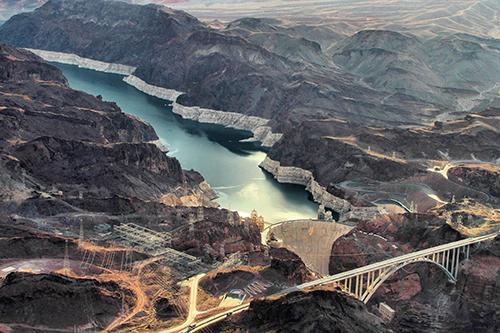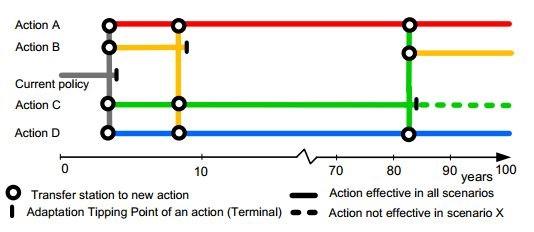
Earlier this month, the National Socio-Environmental Synthesis Center (SESYNC) hosted a policy exchange on new decision-making tools for designing sustainable water infrastructure projects. The multi-institutional meeting was motivated by the SESYNC Pursuit “Climate Change & Water Resources Adaptation: Decision Scaling & Integrated Eco-engineering Resilience,” led by John Matthews of the Alliance for Global Water Adaptation (AGWA) and LeRoy Poff of Colorado State University. Representatives from World Bank, University of Massachusetts Amherst, U.S. Geological Survey, Deltares, and the Organisation for Economic Co-operation and Development (OECD) presented on two decision frameworks that integrate stakeholder participation, risk identification, and adaptation into water resource management.
The meeting engaged a diverse community of research, financial, conservation, federal, and regulatory institutions. Attendees included representatives from AGWA, Climate Bonds Initiative, Colorado State University, Conservation International, International Development Research Centre (IDRC), NASA's Goddard Space Flight Center, OOSKAnews, United Nations Framework Convention on Climate Change (UNFCCC), U.S. Army Corps of Engineers, U.S. Department of State, and World Wildlife Fund.
The frameworks discussed at the SESYNC meeting—“decision scaling,” introduced by Casey Brown et al., and “adaptation pathways,” introduced by Marjolijn Haasnoot et al.—are decision-making guides. They can assist planners and policy makers in developing water infrastructure plans that sustainably manage water resources for both people and natural ecosystems, as well as protect costly investments. What sets these frameworks apart from conventional decision-making tools is how they integrate future shifts in climate.
“According to our internal rules, any new project—whether it’s related to infrastructure, agriculture, or water—has to be screened for potential climate change impacts,” said Marcus Wijnen, Senior Water Resources Management Specialist at World Bank, “and to be sure that the project is designed in such a way that it considers, adapts to, and potentially mitigates those impacts.”
However, the type and degree of future climate variability is largely uncertain—yet decisions often need to be made before adequate information is available. Accordingly, decision makers need tools to assist with developing water infrastructure plans that are economically and ecologically resilient for years to come, under multiple future scenarios. That’s where decision scaling and adaption pathways come in.
“Infrastructure investments are being made now, but climate conditions are changing,” said Haasnoot, Senior Researcher at Deltares. “One of the main questions policy makers and planners are asking themselves is: given these changes, how can we make robust and flexible decisions so that investments are not a waste of money?”
How the Decision-Making Guides Work
The bottom–up approach of decision scaling begins with stakeholder-driven identification of threats to infrastructure performance (such as flooding, which impacts both human and ecological communities) posed by possible future climate conditions (for example, increased precipitation). Next, integrating information from climate models into this so-called “vulnerability domain” provides a sense of how likely those possible threats and impacts will be problematic. The result is a risk-to-benefit analysis, which more reliably informs water resource development and management decisions to produce sustainable infrastructure over a longer period of time.
The adaptation pathways approach describes an iterative sequence of policy actions or infrastructure investments on an as-needed basis over time. The framework identifies tipping points, or conditions at which an action or investment begins to perform unacceptably. Consequentially, additional actions are needed to once again move toward pre-specified objectives. However, each new action also has its own tipping point, so that a new strategy has to again be created. Adaptation maps (see example below) can be used to prepare a plan for actions to be taken immediately, and for preparations that need to be made in order to be able to implement an action in the future in case conditions change.

Above: Example adaptation pathways map. Source
The Ecology of Infrastructure Design
The Climate Change & Water Resources Adaptation Pursuit has been exploring how ecological considerations can be incorporated into engineering design using the decision scaling framework. The idea is that water infrastructure can (and should) contribute to the alleviation of poverty—e.g., through irrigation, clean water, and energy—and at the same time promote or enhance the health of natural ecosystems. Decision scaling can help planners and policy makers determine how to maintain engineering, economic, and ecological resilience over the long lifetimes of water infrastucture in the face of climate uncertainty.
The National Socio-Environmental Synthesis Center, funded through an award to the University of Maryland from the National Science Foundation, is a research center dedicated to solving complex problems at the intersection of human and ecological systems.
Top photo courtesy Airwolfhound via Flickr/Creative Commons